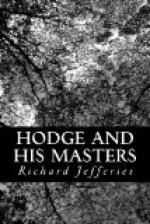As to the soil and strata—the very groundwork of a farm—geology was the true guide to the proper selection of suitable seed. Crops had been garnered by the aid of the electric light, the plough had been driven by the Gramme machine; electricity, then, would play a foremost part in future farming, and should be studied with enthusiasm. Without mathematics nothing could be done; without ornithological study, how know which bird revelled on grain and which destroyed injurious insects? Spectrum analysis detected the adulteration of valuable compounds; the photographer recorded the exact action of the trotting horse; the telephone might convey orders from one end of an estate to the other; and thus you might go through the whole alphabet, the whole cyclopaedia of science, and apply every single branch to agriculture.
It is to be hoped that Phillip’s conversational account of his studies has been correctly reproduced here. The chemical terms look rather weak, but the memory of an ordinary listener can hardly be expected to retain such a mass of technicalities. He had piles of strongly-bound books, the reward of successful examinations, besides diplomas and certificates of proficiency. These subjects could be pursued under cover, but there was besides the field work, which had a more practical sound; model farms to be visited; steam-engines to be seen at work; lectures to be listened to on the spot; deep-drainage operations, a new drill, or a new sheaf-binder to be looked at. Then there were the experimental plots—something like the little parterres seen at the edge of lawns.
One plot was sown without manure, another was sown with manure, a third had a different kind of manure. The dozen mangolds grown in one patch were pulled up and carefully weighed. The grains of wheat in an ear standing in an adjacent patch were counted and recorded. As these plots were about a yard wide, and could be kept clean, no matter what the weather; and as a wheelbarrow load of clay, or chalk, or sand thrown down would alter the geological formation, the results obtained from them were certainly instructive, and would be very useful as a guide to the cultivation of a thousand acres. There was also a large, heavy iron roller, which the scholars could if they chose drag round and round the gravel path.
Architecture, again, touches the agriculturist nearly. He requires buildings for the pigs, cattle, horses, labourers, engine and machinery, lastly, for himself. Out of doors almost any farmhouse that could be visited might be made by a lecturer an illustrative example of what ought to be avoided. Scarcely one could be found that was not full of mistakes—utterly wrong, and erected regardless of design and utility. Within doors, with ink, tracing paper, compasses, straight-edge and ruler, really valuable ground plans, front elevations, and so on, could be laid down. Altogether, with this circle of science to study, the future farmer had very hard work to face. Such exhaustive mental labour induced a certain nervousness that could only be allayed by relaxation. The bicycle afforded a grateful change. Mounted upon the slender, swift-revolving wheel, Mr. Phillip in the cool of the evening, after the long day of study, sometimes proceeded to stretch his limbs. The light cigar soothed his weary and overstrained mind.




